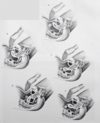Well Woman Exam LECT [Slides 50-105] Flashcards
What are some high risk factors for ALL AGES that require earlier bone mineral density (BMD) screening?
- Hx. of fractures
- Body weight less than 127 lbs
- Current smoker, alcoholic or RA
When would you screen your patients that are younger than 40 w/ mamography?
- Hx of breast cancer in family
- (+) for BRCA1 or BRCA2 mutations
- Hx of high risk biopsy results
What are high risk factors for all ages that require earlier screening for lipid profiles?
BMI > 30
Personal or family h/o DM, PVD
Family h/o familial hyperlipidemia
Family h/o of premature cardiovascular disease
What are the high risk factors for ALL ages that require earlier screening for colorectal related illnesses?
FAMILY HISTORY
Family h/o colorectal cancer
Family h/o familial adenomatous polyposis
Hx of colorectal cancer, polyps, IBD
What population of patients would you consider giving a menigococcal vaccination?
Close quarter living patients (college students in dorms, military recruits)
Patients traveling to hyperendemic areas
Adults w/ asplenia
How do you perform a breast exam?
Either in sitting or supine position
Palpate all quadrants of the breast systematically
Compare size, symmetry, contour, venous pattern, skin and or nipple abnormalities
What should you do for a patient’s first pelvic exam?
Show her the instruments
Inform her of importance of testing
How do you perform a pelvic exam?
Set the head at 30 degrees
Inform patient of position, bottom barely off the end of the table
Warm up the speculum
Adjust light
Put on gloves
What are the major parts of a speculum?
Upper & lower blades
Thumb screw
Thumb hinge
Handle screw
Handle

What are the three types of speculums?
A) Pediatric speculum
B) Pederson speculum
C) Graves speculum

How do you properly insert the speculum?
Make sure bottom is off the end of the table
Warm speculum w/ warm water
Hold speculum w/ dominant hand, take opposite hand and separate labia minora and majora
Direct the speculum at a 45 degree angle
What is super important to remember with insertion of speculums?
Insert the speculum as far as it will go, THEN open the speculum in a smooth and well controlled fashion
If the cervix is not in view after speculum insertion…what do you do? what do you NOT do?
Angle speculum superior or inferior.
DO NOT PULL SPECULUM OUT INITIALLY
If still can’t find cervix after reajustment, remove speculum and perform a bimanual exam.
Review her surgical history and ask if she has had any “female” surgeries
When performing a speculum exam w/ cervical cytology (PAP), what is used first and second?
1st = Spatula to scrape the ectocervix
2nd = Cytobrush obtains endocervical cells
What are the added benefits of using liquid-based prep OVER conventional slide cervical cytology?
Liquid based prep has the added benefits of:
Single specimen can be used to perform
- Cytology
- HPV testing
- Evaluate ASCUS cytology
- Test for Gonorrhea and chlamydia




